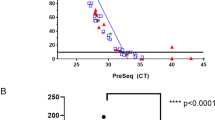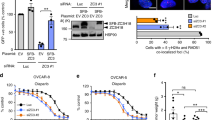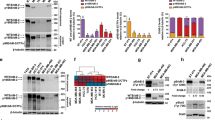Abstract
Nuclear protein in testis (NUT)-midline carcinoma (NMC) is a rare, aggressive disease typically presenting with a single t(15;19) translocation that results in the generation of a bromodomain-containing protein 4 (BRD4)–NUT fusion. PER-624 is a cell line generated from an NMC patient with an unusually complex karyotype that gave no initial indication of the involvement of the NUT locus. Analysis of PER-624 next-generation transcriptome sequencing (RNA-Seq) using the algorithm FusionFinder identified a novel transcript in which Exon 15 of BRD4 was fused to Exon 2 of NUT, therefore differing from all published NMC fusion transcripts. The three additional exons contained in the PER-624 fusion encode a series of polyproline repeats, with one predicted to form a helix. In the NMC cell line PER-403, we identified the ‘standard’ NMC fusion and two novel isoforms. Knockdown by small interfering RNA in either cell line resulted in decreased proliferation, increased cell size and expression of cytokeratins consistent with epithelial differentiation. These data demonstrate that the novel BRD4–NUT fusion in PER-624 encodes a functional protein that is central to the oncogenic mechanism in these cells. Genomic PCR indicated that in both PER-624 and PER-403, the translocation fuses an intron of BRD4 to a region upstream of the NUT coding sequence. Thus, the generation of BRD4–NUT fusion transcripts through post-translocation RNA-splicing appears to be a common feature of these carcinomas that has not previously been appreciated, with the mechanism facilitating the expression of alternative isoforms of the fusion. Finally, ectopic expression of wild-type NUT, a protein normally restricted to the testis, could be demonstrated in PER-403, indicating additional pathways for aberrant cell signaling in NMC. This study contributes to our understanding of the genetic diversity of NMC, an important step towards finding therapeutic targets for a disease that is refractory to current treatments.
This is a preview of subscription content, access via your institution
Access options
Subscribe to this journal
Receive 50 print issues and online access
$259.00 per year
only $5.18 per issue
Buy this article
- Purchase on Springer Link
- Instant access to full article PDF
Prices may be subject to local taxes which are calculated during checkout







Similar content being viewed by others
References
French CA . Pathogenesis of NUT midline carcinoma. Annu Rev Pathol 2012; 7: 247–265.
French CA, Ramirez CL, Kolmakova J, Hickman TT, Cameron MJ, Thyne ME et al. BRD-NUT oncoproteins: a family of closely related nuclear proteins that block epithelial differentiation and maintain the growth of carcinoma cells. Oncogene 2008; 27: 2237–2242.
Shehata BM, Steelman CK, Abramowsky CR, Olson TA, French CA, Saxe DF et al. NUT midline carcinoma in a newborn with multiorgan disseminated tumor and a 2-year-old with a pancreatic/hepatic primary. Pediatr Dev Pathol 2010; 13: 481–485.
French CA . Demystified molecular pathology of NUT midline carcinomas. J Clin Pathol 2010; 63: 492–496.
Kees UR, Mulcahy MT, Willoughby ML . Intrathoracic carcinoma in an 11-year-old girl showing a translocation t(15;19). Am J Pediatr Hematol Oncol 1991; 13: 459–464.
Kubonishi I, Takehara N, Iwata J, Sonobe H, Ohtsuki Y, Abe T et al. Novel t(15;19)(q15;p13) chromosome abnormality in a thymic carcinoma. Cancer Res 1991; 51: 3327–3328.
Kuzume T, Kubonishi I, Takeuchi S, Takeuchi T, Iwata J, Sonobe H et al. Establishment and characterization of a thymic carcinoma cell line (Ty-82) carrying t(15;19)(q15;p13) chromosome abnormality. Int J Cancer 1992; 50: 259–264.
Bauer D, Mitchell C, Strait K, Lathan C, Stelow E, Lueer S et al. Clinicopathologic features and long-term outcomes of NUT midline carcinoma. Clin Cancer Res 2012; 18: 5773–5779.
French CA, Kutok JL, Faquin WC, Toretsky JA, Antonescu CR, Griffin CA et al. Midline carcinoma of children and young adults with NUT rearrangement. J Clin Oncol 2004; 22: 4135–4139.
Reynoird N, Schwartz BE, Delvecchio M, Sadoul K, Meyers D, Mukherjee C et al. Oncogenesis by sequestration of CBP/p300 in transcriptionally inactive hyperacetylated chromatin domains. EMBO J 2010; 29: 2943–2952.
Schwartz BE, Hofer MD, Lemieux ME, Bauer DE, Cameron MJ, West NH et al. Differentiation of NUT midline carcinoma by epigenomic reprogramming. Cancer Res 2011; 71: 2686–2696.
Toretsky JA, Jenson J, Sun CC, Eskenazi AE, Campbell A, Hunger SP et al. Translocation (11;15;19): a highly specific chromosome rearrangement associated with poorly differentiated thymic carcinoma in young patients. Am J Clin Oncol 2003; 26: 300–306.
Vargas SO, French CA, Faul PN, Fletcher JA, Davis IJ, Dal Cin P et al. Upper respiratory tract carcinoma with chromosomal translocation 15;19: evidence for a distinct disease entity of young patients with a rapidly fatal course. Cancer 2001; 92: 1195–1203.
Haack H, Johnson LA, Fry CJ, Crosby K, Polakiewicz RD, Stelow EB et al. Diagnosis of NUT midline carcinoma using a NUT-specific monoclonal antibody. Am J Surg Pathol 2009; 33: 984–991.
French CA, Miyoshi I, Aster JC, Kubonishi I, Kroll TG, Dal Cin P et al. BRD4 bromodomain gene rearrangement in aggressive carcinoma with translocation t(15;19). Am J Pathol 2001; 159: 1987–1992.
French CA, Miyoshi I, Kubonishi I, Grier HE, Perez-Atayde AR, Fletcher JA . BRD4-NUT fusion oncogene: a novel mechanism in aggressive carcinoma. Cancer Res 2003; 63: 304–307.
Tanaka M, Kato K, Gomi K, Yoshida M, Niwa T, Aida N et al. NUT midline carcinoma: Report of 2 Cases Suggestive of Pulmonary Origin. Am J Surg Pathol 2012; 36: 381–388.
Engleson J, Soller M, Panagopoulos I, Dahlen A, Dictor M, Jerkeman M . Midline carcinoma with t(15;19) and BRD4-NUT fusion oncogene in a 30-year-old female with response to docetaxel and radiotherapy. BMC Cancer 2006; 6: 69.
Haruki N, Kawaguchi KS, Eichenberger S, Massion PP, Gonzalez A, Gazdar AF et al. Cloned fusion product from a rare t(15;19)(q13.2;p13.1) inhibit S phase in vitro. J Med Genet 2005; 42: 558–564.
Francis RW, Thompson-Wicking K, Carter KW, Anderson D, Kees UR, Beesley AH . FusionFinder: a software tool to identify expressed gene fusion candidates from RNA-Seq data. PLoS One 2012; 7: e39987.
Yan J, Diaz J, Jiao J, Wang R, You J . Perturbation of BRD4 protein function by BRD4-NUT protein abrogates cellular differentiation in NUT midline carcinoma. J Biol Chem 2011; 286: 27663–27675.
Mertens F, Wiebe T, Adlercreutz C, Mandahl N, French CA . Successful treatment of a child with t(15;19)-positive tumor. Pediatr Blood Cancer 2007; 49: 1015–1017.
Filippakopoulos P, Qi J, Picaud S, Shen Y, Smith WB, Fedorov O et al. Selective inhibition of BET bromodomains. Nature 2010; 468: 1067–1073.
Dawson MA, Prinjha RK, Dittmann A, Giotopoulos G, Bantscheff M, Chan WI et al. Inhibition of BET recruitment to chromatin as an effective treatment for MLL-fusion leukaemia. Nature 2011; 478: 529–533.
Zuber J, Shi J, Wang E, Rappaport AR, Herrmann H, Sison EA et al. RNAi screen identifies Brd4 as a therapeutic target in acute myeloid leukaemia. Nature 2011; 478: 524–528.
Ott CJ, Kopp N, Bird L, Paranal RM, Qi J, Bowman T et al. BET bromodomain inhibition targets both c-MYC and IL7R in high-risk acute lymphoblastic leukemia. Blood 2012; 120: 2843–2852.
Delmore JE, Issa GC, Lemieux ME, Rahl PB, Shi J, Jacobs HM et al. BET bromodomain inhibition as a therapeutic strategy to target c-Myc. Cell 2011; 146: 904–917.
Prinjha RK, Witherington J, Lee K . Place your BETs: the therapeutic potential of bromodomains. Trends Pharmacol Sci 2012; 33: 146–153.
Belkina AC, Denis GV . BET domain co-regulators in obesity, inflammation and cancer. Nat Rev Cancer 2012; 12: 465–477.
Trapnell C, Pachter L, Salzberg SL . TopHat: discovering splice junctions with RNA-Seq. Bioinformatics 2009; 25: 1105–1111.
Acknowledgements
This work was supported by grants from the Children’s Leukemia and Cancer Research Foundation (CLCRF, Perth, Western Australia, Australia), Apache Energy Limited, the Cancer Council of Western Australia, the University of Western Australia and the WA State Government Centers of Excellence Program. We would like to thank Maxine Crook, Senior Medical Scientist, PathWest Laboratory Medicine, Perth, for performing the IHC used in this study.
Author information
Authors and Affiliations
Corresponding author
Ethics declarations
Competing interests
The authors declare no conflict of interest.
Additional information
Supplementary Information accompanies the paper on the Oncogene website
Supplementary information
Rights and permissions
About this article
Cite this article
Thompson-Wicking, K., Francis, R., Stirnweiss, A. et al. Novel BRD4–NUT fusion isoforms increase the pathogenic complexity in NUT midline carcinoma. Oncogene 32, 4664–4674 (2013). https://doi.org/10.1038/onc.2012.487
Received:
Revised:
Accepted:
Published:
Issue Date:
DOI: https://doi.org/10.1038/onc.2012.487
Keywords
This article is cited by
-
Structural mechanism of BRD4-NUT and p300 bipartite interaction in propagating aberrant gene transcription in chromatin in NUT carcinoma
Nature Communications (2023)
-
Incidence of NUT carcinoma in Western Australia from 1989 to 2014: a review of pediatric and adolescent cases from Perth Children’s Hospital
BMC Cancer (2021)
-
Update on genetically defined lung neoplasms: NUT carcinoma and thoracic SMARCA4-deficient undifferentiated tumors
Virchows Archiv (2021)
-
A novel NAP1L4/NUTM1 fusion arising from translocation t(11;15)(p15;q12) in a myeloid neoplasm with eosinophilia and rearrangement of PDGFRA highlights an unusual clinical feature and therapeutic reaction
Annals of Hematology (2020)
-
A novel BRD4-NUT fusion in an undifferentiated sinonasal tumor highlights alternative splicing as a contributing oncogenic factor in NUT midline carcinoma
Oncogenesis (2015)



